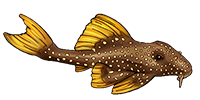https://doi.org/10.1016/j.ympev.2019.05.017
Highlights
- The phylogeny of was evaluated using a multilocus approach.
- The monophyly of the genus was confirmed.
- Five Hypophthalmus lineages were observed, including two putative new species.
- The results suggest that the true diversity of the genus is underestimated.
- Evidence was found of introgression between Hypophthalmus species.
Abstract
The genus encompasses four valid South American freshwater catfish species: H. marginatus, H. edentatus, H. fimbriatus, and H. oremaculatus. More recently two new species were proposed Hypophthalmus n. sp. 1 and Hypophthalmus n. sp. 2. While Hypophthalmus species are a fundamentally important resource for the commercial fisheries that operate in the continental waters of the Amazon basin, their phylogenetic relationships and the true diversity of the genus have yet to be defined conclusively. Given this, the present study analyzed sequences of the mitochondrial COI gene and four nuclear markers (RAG2, Myh6, Plagl2 and Glyt) to evaluate the phylogenetic relationships and the diversity of the species of this genus. All the analyses showed that Hypophthalmus is monophyletic, and the species delimitation tests recovered all the Hypophthalmus taxa as distinct species. The putative new species Hypophthalmus n. sp. 1 and Hypophthalmus n. sp. 2 presented mean genetic divergence similar to or greater than that observed between valid Hypophthalmus taxa. All the analyses showed that H. oremaculatus is the sister group of H. n. sp. 1, which together group with H. fimbriatus. This clade is the sister group of the clade containing H. edentatus and H. n. sp. 2. One specimen, morphologically identified as H. oremaculatus, presented the nuclear genome of this species and the mitochondrial genome of H. n. sp. 1; while another specimen, morphologically identified as H. n. sp. 2, presented the nuclear Myh6 of H. n. sp. 2 and the mitochondrial and RAG2 genome of H. edentatus. These results indicate that hybridization and introgression has occurred between species in Hypophthalmus. The findings of this study indicate that the diversity of the Hypophthalmus is underestimated, emphasize the need for a taxonomic review of the genus, and a more systematic evaluation of the hybridization patterns found, to understanding the role of hybridization and introgression in the evolution of the genus.





